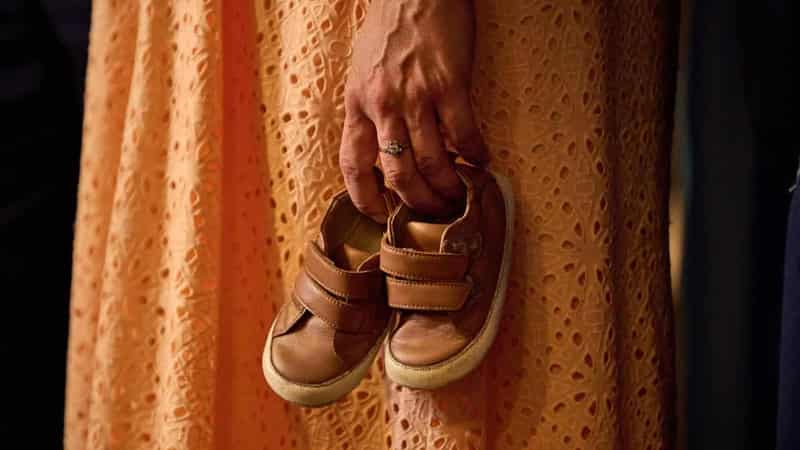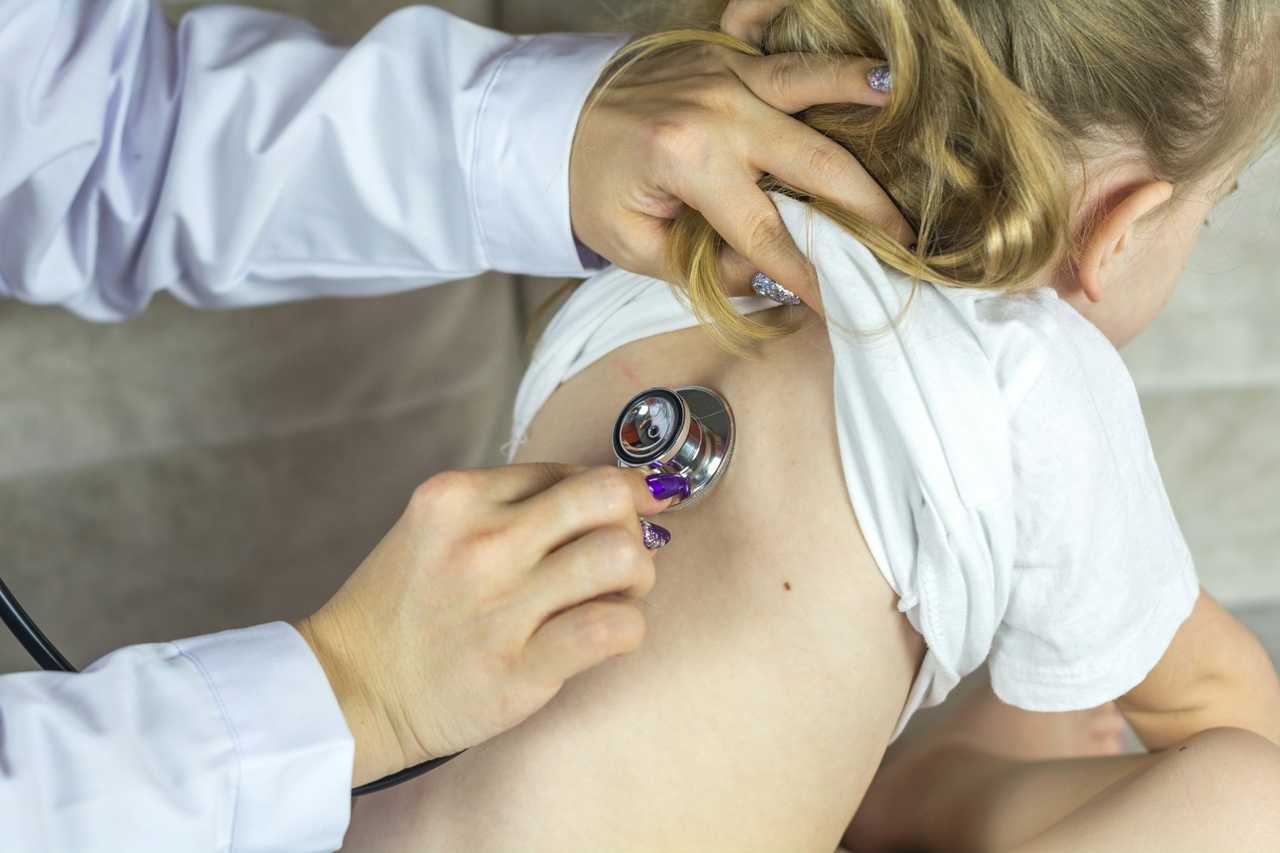Best & Worst States for Children’s Health Care (2025)
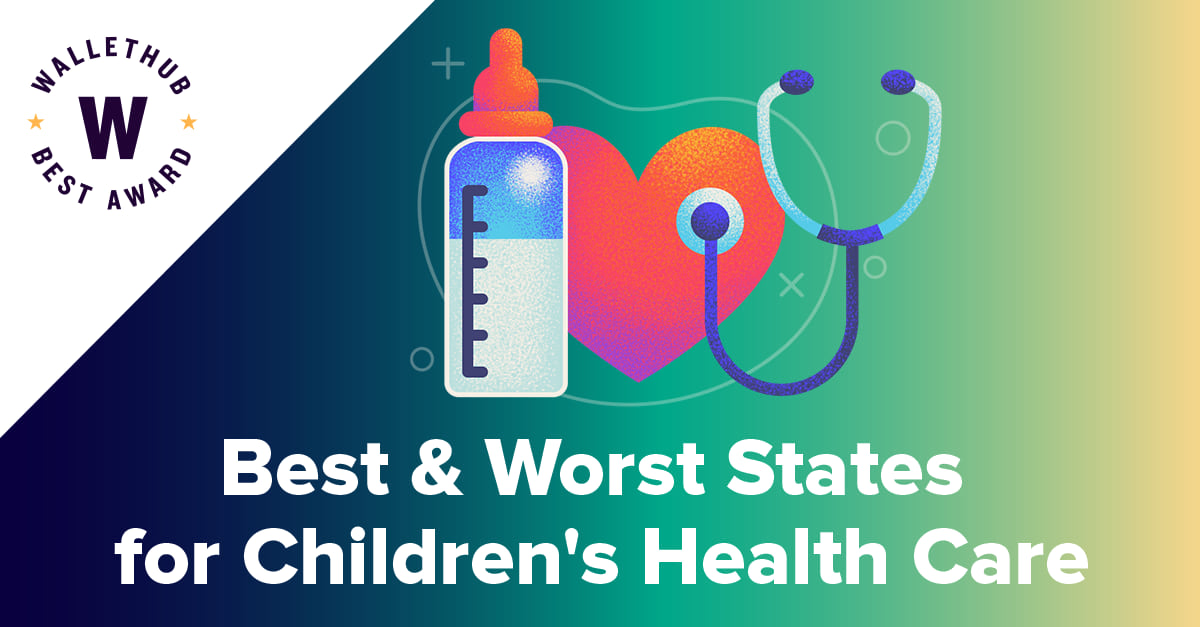
Keeping children healthy is as expensive as it is essential. Luckily, around 95% of children ageds 0 to 18 have health insurance to protect them if they do get sick. The bad news is that the high coverage rate hasn’t translated to lower health costs for parents, and the average amount workers pay toward employer-sponsored family coverage is nearly $6,300 per year. Some families can find relief through Medicaid or through the Children’s Health Insurance Program (CHIP). However, many people who don’t qualify for government assistance will still struggle, especially when their wallets are already hurting from high inflation.
Cost isn’t the only important factor for children’s health care, though. Other things that play a big role include the quality of the health care system and environmental factors like access to healthy food and fluoridated water.
It’s a different story in every state, though. WalletHub therefore compared the 50 states and the District of Columbia across 33 key indicators of cost, quality and access to children’s health care. Our data set ranges from the share of children aged 0 to 17 in excellent or very good health to pediatricians and family doctors per capita.

“The quality of children’s health care should be one of the most important considerations for parents when deciding where to live. Having access to quality pediatric and dental care, nutritious food and good spaces for recreation from a young age can give children a much better chance of growing up healthy and forming good habits that will last into their adult life.”
Chip Lupo, WalletHub Analyst
Main Findings
Best States for Children’s Health
|
Overall Rank |
State |
Total Score |
Kids’ Health & Access to Health Care Rank |
Kids’ Nutrition, Physical Activity & Obesity Rank |
Kids’ Oral Health Rank |
|---|---|---|---|---|---|
| 1 | Massachusetts | 67.31 | 2 | 1 | 20 |
| 2 | Rhode Island | 64.88 | 1 | 7 | 16 |
| 3 | New Jersey | 63.15 | 4 | 3 | 51 |
| 4 | Pennsylvania | 61.45 | 8 | 8 | 6 |
| 5 | Vermont | 61.25 | 3 | 28 | 3 |
| 6 | District of Columbia | 60.52 | 5 | 27 | 1 |
| 7 | Hawaii | 60.23 | 6 | 21 | 42 |
| 8 | New York | 60.19 | 10 | 12 | 21 |
| 9 | Connecticut | 60.10 | 7 | 18 | 29 |
| 10 | California | 59.67 | 11 | 13 | 24 |
| 11 | Maryland | 59.46 | 9 | 20 | 36 |
| 12 | Washington | 59.03 | 14 | 4 | 46 |
| 13 | Minnesota | 58.19 | 17 | 5 | 32 |
| 14 | Illinois | 57.16 | 12 | 32 | 2 |
| 15 | Utah | 57.11 | 22 | 2 | 48 |
| 16 | Delaware | 56.56 | 18 | 15 | 15 |
| 17 | Colorado | 55.80 | 29 | 6 | 13 |
| 18 | New Hampshire | 55.51 | 13 | 38 | 27 |
| 19 | Nebraska | 55.41 | 21 | 22 | 9 |
| 20 | Iowa | 55.12 | 19 | 24 | 14 |
| 21 | Virginia | 55.11 | 16 | 26 | 38 |
| 22 | Oregon | 54.50 | 28 | 10 | 12 |
| 23 | Michigan | 54.29 | 27 | 19 | 8 |
| 24 | Idaho | 54.27 | 15 | 37 | 26 |
| 25 | New Mexico | 53.87 | 24 | 25 | 5 |
| 26 | Missouri | 53.24 | 31 | 14 | 39 |
| 27 | Ohio | 52.55 | 20 | 42 | 22 |
| 28 | South Dakota | 52.02 | 26 | 30 | 28 |
| 29 | South Carolina | 52.00 | 25 | 33 | 23 |
| 30 | Indiana | 51.98 | 33 | 23 | 34 |
| 31 | North Dakota | 51.35 | 36 | 17 | 4 |
| 32 | Alabama | 50.33 | 23 | 47 | 31 |
| 33 | Montana | 50.22 | 39 | 11 | 43 |
| 34 | Nevada | 49.91 | 30 | 36 | 49 |
| 35 | Tennessee | 49.56 | 32 | 44 | 25 |
| 36 | Florida | 49.55 | 41 | 16 | 45 |
| 37 | Wisconsin | 49.28 | 46 | 9 | 18 |
| 38 | Kentucky | 48.75 | 34 | 45 | 11 |
| 39 | Georgia | 48.60 | 37 | 34 | 7 |
| 40 | Kansas | 47.88 | 42 | 29 | 19 |
| 41 | North Carolina | 47.83 | 35 | 35 | 41 |
| 42 | Louisiana | 46.28 | 40 | 41 | 47 |
| 43 | Maine | 45.71 | 38 | 51 | 17 |
| 44 | Arkansas | 45.61 | 44 | 43 | 37 |
| 45 | West Virginia | 45.32 | 43 | 48 | 10 |
| 46 | Arizona | 44.76 | 47 | 40 | 30 |
| 47 | Oklahoma | 43.49 | 45 | 46 | 50 |
| 48 | Alaska | 43.05 | 48 | 50 | 33 |
| 49 | Wyoming | 41.80 | 49 | 39 | 44 |
| 50 | Texas | 40.72 | 50 | 31 | 40 |
| 51 | Mississippi | 37.83 | 51 | 49 | 35 |
Note: With the exception of “Total Score,” all of the columns in the table above depict the relative rank of that state, where a rank of 1 represents the best conditions for that metric category.

Highest
- Highest
- T-1. Utah
- T-1. Idaho
- T-3. South Dakota
- T-3. Nebraska
- 5. New Hampshire

Lowest
- Lowest
- 47. Louisiana
- 48. Texas
- 49. New Mexico
- 50. Arizona
- 51. Mississippi

Lowest
- Lowest
- 1. Massachusetts
- 2. Vermont
- 3. New York
- 4. District of Columbia
- 5. Rhode Island

Highest
- Highest
- 47. Alaska
- 48. Oklahoma
- 49. Arizona
- 50. Wyoming
- 51. Texas
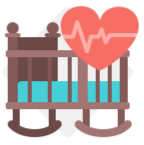
Lowest
- Lowest
- 1. Massachusetts
- 2. New Hampshire
- 3. New Jersey
- 4. Rhode Island
- 5. California

Highest
- Highest
- 47. Louisiana
- 48. West Virginia
- 49. Arkansas
- 50. South Dakota
- 51. Mississippi
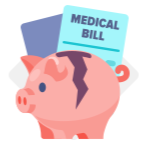
Lowest
- Lowest
- 1. Rhode Island
- 2. Hawaii
- 3. Washington
- 4. New Mexico
- 5. California

Highest
- Highest
- 47. Florida
- 48. Nebraska
- T-49. Wyoming
- T-49. Nevada
- 51. Texas

Most
- Most
- 1. Delaware
- 2. Arizona
- 3. Pennsylvania
- 4. Vermont
- 5. Alaska

Fewest
- Fewest
- 47. North Dakota
- 48. West Virginia
- 49. Nevada
- 50. Louisiana
- 51. Kansas

Lowest
- Lowest
- 1. Idaho
- 2. Hawaii
- 3. New Jersey
- 4. Washington
- 5. Massachusetts

Highest
- Highest
- 47. Michigan
- T-48. New Mexico
- T-48. Mississippi
- 50. Nevada
- 51. District of Columbia
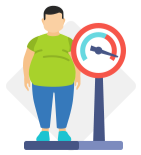
Lowest
- Lowest
- T-1. New Hampshire
- T-1. Vermont
- 3. Minnesota
- 4. Utah
- 5. Colorado

Highest
- Highest
- 47. Arkansas
- 48. Alabama
- 49. Louisiana
- 50. West Virginia
- 51. Mississippi

Highest
- Highest
- T-1. District of Columbia
- T-1. Connecticut
- 3. New Hampshire
- 4. Massachusetts
- 5. Vermont

Lowest
- Lowest
- 47. North Carolina
- 48. Missouri
- 49. Nevada
- 50. Mississippi
- 51. Oklahoma

Highest
- Highest
- 1. Vermont
- 2. New Hampshire
- 3. District of Columbia
- 4. Massachusetts
- 5. Connecticut

Lowest
- Lowest
- 47. Oklahoma
- 48. Texas
- 49. Florida
- 50. Nevada
- 51. Mississippi
Show More
In-Depth Look at the Best States for Children’s Health
Massachusetts
Massachusetts is the best state for children’s health, with the fourth-highest percentage of children who had both a medical and a dental preventative care visit in the past 12 months. Access to preventative care helps children avoid serious medical issues and also minimizes costs for parents.
In the Bay State, only 1.5% of children lack health insurance, the lowest uninsured rate of any state. Massachusetts also has the lowest infant mortality rates in the country and one of the lowest death rates for children ages 14 and under.
In addition, children in Massachusetts drink soda at a lower rate than in any other state, which contributes to their health, especially their dental health.
Rhode Island
Rhode Island is the second-best state for children’s health care, and only 5.6% of residents have trouble paying their children’s medical bills, the lowest rate in the country. That’s due in part to the fact that Rhode Island has the fifth-lowest percentage of children who are uninsured. The Ocean State also has the second-highest number of children’s hospitals per capita and the seventh-lowest out-of-pocket costs for children’s health care.
Most importantly, Rhode Island has one of the lowest death rates for children under age 14, and one major contributing factor to that statistic is the fact that parents vaccinate their children at high rates. Nearly 86% of children 19-35 months old have the combined 7-vaccine series, which protects against diphtheria, pertussis, tetanus, poliovirus, measles, mumps, rubella, hepatitis b, Haemophilus influenzae type b, varicella, and pneumococcal infections, according to the CDC.
New Jersey
New Jersey ranks as the third-best state for children’s health care, thanks to its high number of children’s hospitals per capita and one of the lowest cost of doctor’s visit in the country.
New Jersey promotes healthy diets, as the state has the sixth-lowest percentage of children who eat vegetables less than once per day. The state also has the third-lowest rate of students drinking soda or pop daily. These factors have contributed to New Jersey having the third-lowest share of children who are overweight in the country.
In addition, New Jersey has one of the lowest infant mortality rates in the nation, which is indicative of the state’s robust newborn healthcare system. The state’s dedication to child safety, wellbeing, and high-quality medical care is further evidenced by the fact that it has the lowest death rate for children under the age of 14.
Ask the Experts
There are steps that parents, health-care organizations and the government can take to ensure the best health for children in the U.S. For insight and advice, we asked a panel of experts to share their thoughts on the following key questions:
- What are the most important steps parents can take to help their children grow up healthy?
- Do you think the government should mandate that all children have health insurance coverage?
- In evaluating the best states for children’s healthcare, what are the top 5 indicators?
- How have utilization of preventive and primary care among children changed in recent years?
- With America’s youth facing an ongoing mental health crisis, and nearly 60% of those with major depression not receiving treatment, what actions can parents and health care providers take to mitigate this issue?
Gustavo Carlo
Professor and Director, Cultural Resiliency and Learning Center, Equity Advisor, School of Education – University of California, Irvine
Read More
Lise M. Youngblade
Ph.D. – Dean, College of Health and Human Sciences – Colorado State University
Read More
Abram L. Brummett
Ph.D., HEC-C – Assistant Professor, Department of Foundational Medical Studies – Oakland University William Beaumont School of Medicine
Read More
Lawrence Gostin
Distinguished University Professor; Founding O’Neill Chair in Global Health Law / Co-Faculty Director, O’Neill Institute / Director, WHO Collaborating Center on Global Health Law – Georgetown Law
Read More
Michael Doonan
Ph.D. – Professor, The Schneider Institutes for Health Policy, The Heller School for Social Policy and Management – Brandeis University
Read More
Christopher Plein
Ph.D. – Eberly Family Professor for Outstanding Public Service, Professor of Public Administration, John D. Rockefeller IV School of Policy and Politics and Adjunct Specialist, WVU Extension Family and Community Development – West Virginia University
Read More
Methodology
In order to determine the best and worst states for children’s health care, WalletHub compared the 50 states and the District of Columbia across three key dimensions: 1) Kids’ Health & Access to Health Care, 2) Kids’ Nutrition, Physical Activity & Obesity and 3) Kids’ Oral Health.
We evaluated these categories using 33 relevant metrics, which are listed below with their corresponding weights. Each metric was graded on a 100-point scale, with 100 representing the best health care for children.
We then determined each state and the District’s weighted average across all metrics to calculate its overall score and used the resulting scores to rank-order our sample.
Kids’ Health & Access to Health Care – Total Points: 55
- Share of Children Aged 0 to 17 in Excellent/Very Good Health: Double Weight (~8.46 Points)
- Share of Children Aged 3 to 17 Suffering from Depression: Full Weight (~4.23 Points)
- Infant-Death Rate: Full Weight (~4.23 Points)
Note: “Infant” includes children who are less than 1 year old. - Child-Death Rate: Full Weight (~4.23 Points)
Note: “Child” includes children aged 1 to 14. - Share of Children 19 to 35 Months Old with All Recommended Vaccines: Full Weight (~4.23 Points)
Note: Recommended vaccines include the following: DTaP vaccine; polio vaccine; measles, mumps and rubella (MMR) vaccine; Haemophilus influenzae type b (Hib) vaccine; varicella (chicken pox) vaccine; hepatitis B (HepB) vaccine; and pneumococcal conjugate vaccine (PCV). - Share of Uninsured Children Aged 0 to 18: Double Weight (~8.46 Points)
- Share of Children Aged 0 to 17 with Unaffordable Medical Bills: Full Weight (~4.23 Points)
Note: This metric measures the percentage of children aged 0 to 17 whose families had problems paying or were unable to pay their child’s medical bills. - Pediatricians & Family Doctors per Capita: Full Weight (~4.23 Points)
- Cost of Doctor’s Visit: Full Weight (~4.23 Points)
- Out-of-Pocket Cost for Children’s Health Care: Full Weight (~4.23 Points)
- Number of Children’s Hospitals per Total Number of Children: Full Weight (~4.23 Points)
Kids’ Nutrition, Physical Activity & Obesity – Total Points: 40
- Healthy-Food Access: Full Weight (~2.86 Points)
Note: This metric measures the share of low income population that is more than 1 mile (urban areas) or more than 10 miles (rural areas) from the nearest supermarket, supercenter, or large grocery store. - Sugar-Sweetened Beverage Consumption Among Children Aged 14 to 18: Full Weight (~2.86 Points)
- Share of Children Aged 14 to 18 Who Consume Fruits/Vegetables Less than Once Daily: Full Weight (~2.86 Points)
- Fast-Food Restaurants per Capita: Full Weight (~2.86 Points)
- Dietitians & Nutritionists per Capita: Full Weight (~2.86 Points)
- Share of Children Aged 6 to 17 Who Exercise at Least 60 Minutes per Day: Full Weight (~2.86 Points)
- Share of Overweight Children Aged 10 to 17: Double Weight (~5.71 Points)
- Share of Obese Children Aged 10 to 17: Double Weight (~5.71 Points)
- Presence of Healthy Eating and Physical Activity Policies in Schools: Full Weight (~2.86 Points)
Note: This binary metric considers the presence or absence of Early Childhood Education (ECE) programs required to have healthy eating policies and Physical Education requirements for elementary, middle and high school. - Schools Meeting Nutrition Standards: Full Weight (~2.86 Points)
Note: This metric measures 1) the share of eligible school districts adopting the Community Eligibility Provision Take-Up, 2) the share of certified school food authorities and 3) the share of children in the School Lunch Program that are also in the School Breakfast Program. - Presence of Obesity-Related State Initiatives: Full Weight (~2.86 Points)
Note: This metric considers the presence or absence of obesity-related state initiatives such as menu-labeling laws and soda taxes. - Share of Children Aged 1 to 17 Who Live Near a Recreation Area: Full Weight (~2.86 Points)
Note: This metric measures the share of children aged 1 to 17 who live near a park/playground and recreation/community center.
Kids’ Oral Health – Total Points: 5
- Share of Children Aged 1 to 17 with Excellent/Very Good Teeth: Double Weight (~0.83 Points)
- Share of Children Aged 0 to 17 with Recent Medical & Dental Checkups: Double Weight (~0.83 Points)
- Share of Population Lacking Access to Fluoridated Water: Full Weight (~0.42 Points)
- Presence of State Oral Health Plan: Full Weight (~0.42 Points)
Note: This metric considers the presence or absence of state oral health plans. According to the Centers for Disease Control and Prevention, “A state oral health plan is a roadmap for accomplishing the goals and objectives that have been developed in collaboration with partners and stakeholders, including the state oral health coalition, and members from the public health, dental and medical communities. A comprehensive state oral health plan should be used to direct skilled personnel and funding decisions to reduce the prevalence of oral disease.” - Presence of School-Based Dental-Sealant Programs: Full Weight (~0.42 Points)
Note: This binary metric considers the presence or absence of school-based dental sealant programs. According to the Centers for Disease Control and Prevention, “School-based sealant programs provide pit and fissure sealants to children in a school setting. These programs generally target vulnerable populations that may be at greater risk for developing decay and less likely to receive preventive care.” - Dental Treatment Costs: Full Weight (~0.42 Points)
Note: “Dental Treatment” includes children’s braces, cleanings, crowns, root canals and tooth extractions. - Free or Low-Cost Dental Clinics per Capita: Full Weight (~0.42 Points)
- Presence of State Mandate for Dental-Health Screening: Full Weight (~0.42 Points)
Note: This binary metric considers the presence or absence of a mandatory dental-health screening or certification of a dental-health assessment as a condition of school entry. - Share of Dentists Participating in Medicaid for Child Dental Services: Full Weight (~0.42 Points)
- Dentists per Capita: Full Weight (~0.42 Points)
Sources: Data used to create this ranking were collected as of March 11, 2025 from U.S. Census Bureau, Bureau of Labor Statistics, Child and Adolescent Health Measurement Initiative, Centers for Disease Control and Prevention, Council for Community and Economic Research, U.S. Department of Agriculture, American Dental Association, Trust for America’s Health, Free Dental Care, The Annie E. Casey Foundation, Healthy Grid and U.S. News & World Report.
Supporting Video Files:
Was this article helpful?
link







